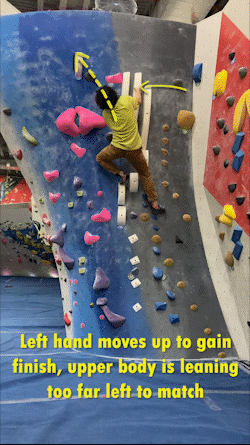Breakdown
Climber: Greg Berg 6’2”/+0
Wall Angle: Flat
Holds: Rock Candy Blockus Pinches, Urban Plastix Complex Geo Feet
RIC: Risk 2, Intensity 2, Complexity 3
This boulder was designed to give the climber a well-rounded experience at a mid-grade. Complexity is ranked highest on this climb because body positioning is crucial and proper weight shifts between movements are needed to maintain balance. Intensity is present on this boulder because of the constant tension between hands and feet. However, intensity can be lowered with correct sequencing. Risk is also a factor because the starting footholds are small and insecure.
Influence/Aesthetic:
For this climb, I wanted to present a situation that is not commonly seen; vertical pinches on a flat wall. The only intention for movement prior to setting the boulder was to have the climber shift back and forth over a center point. Presenting the pinches in lines creates visual conformity, but also restricts the climber to follow these lines. Merging these observable and interactive traits helps climbers draw parallels between route reading and the feeling of movement during attempts.
Hold Selection:
Choosing holds for this boulder was streamlined because all of the hand holds were from the same set. Using holds from the same set is often the easiest way to create a theme throughout a climb. However, if the set is all the same type of holds (ex. crimps, pinches, slopers), this can be polarizing. Climbers often have a preferred grip type and will avoid types that they do not perform well on. Setting climbs that are restricted to a specific hold type helps users improve their weaknesses.
High Stepper
Greg begins the boulder by pulling on the start hold from the left to face the directional feet.
The following holds are farther right. This causes him to begin moving his hands up and continually shift his weight rightward.
Once his right hand is in line with the footholds, his weight becomes more centered. This allows him to bring his left foot inward and walk his feet up.
Twists and Turns
Moving his hands rightward allows Greg to continually move his feet higher. However, his left hand becomes low enough that he is unable to move his right hand.
In order to gain the next left hand, he flags his right foot to square his body and prevent himself from falling too far right.
He begins to walk his feet back leftward to gain opposition for his left hand.
Bring it Back
Once Greg weights his left hand he is able to move his right hand but is unable to weight it.
He places his left foot on and drops his right foot to center his weight directly under the pinches. This point of contact allows him to begin shifting leftward.
Bringing his right hand into the middle pinch creates a constriction for his hands but starts his movement over his body’s midline.
Take the Top
Reaching the finish provides tension between Greg’s hands, letting his feet move freely.
His upper body is leaning far leftward with his legs reaching rightward, which creates an imbalance.
Greg uses a heel hook to generate a high amount of tension between his feet and hands. This prevents his body from falling too far leftward when matching the finish.
Final Thoughts
Setting boulders that use repetition to test specific skill sets can be tricky. There is a thin line between encouraging climbers to get out of their comfort zone and turning them away. Climbs that present an immediate challenge through an aesthetic like distance of holds, size of holds, or grip type can cause users self-doubt depending on their strengths and weaknesses. However, combining the emphasized skill or aesthetic (pinches) with a contrasting one (balance) can provide climbers with a wider lens to look through when determining their impressions.




